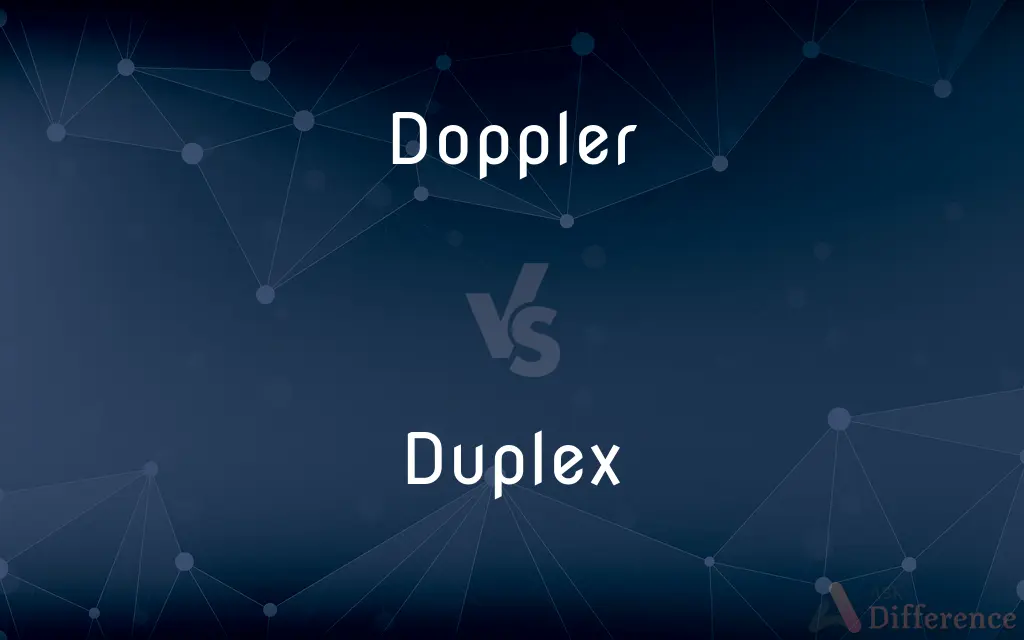Doppler vs. Duplex — What's the Difference?
By Tayyaba Rehman & Urooj Arif — Updated on April 21, 2024
Doppler refers to the Doppler effect, a phenomenon used to measure changes in frequency due to the motion of a source or observer; Duplex, in technology, refers to communication that happens bidirectionally, either simultaneously or alternately.

Difference Between Doppler and Duplex
Table of Contents
ADVERTISEMENT
Key Differences
Doppler primarily deals with the Doppler effect, which observes changes in wave frequency resulting from the motion relative to a source and an observer. On the other hand, duplex refers to a mode of communication where information can flow in two directions, either simultaneously in full duplex or alternately in half duplex.
While Doppler techniques are critical in fields like astronomy, medical imaging (e.g., Doppler ultrasound), and radar systems, which utilize the effect to measure velocity or movement, duplex systems are foundational in telecommunications, enabling interactive communication like telephone conversations or computer networking.
In practical use, a Doppler radar measures the speed and direction of weather phenomena, aiding meteorological predictions. Conversely, duplex communication systems like radios use specific protocols to manage simultaneous sending and receiving of signals, enhancing communication reliability.
The concept of Doppler is inherently linked to physical phenomena and natural sciences, relying on the properties of waves and their interaction with moving objects. In contrast, duplex is a concept rooted in engineering and information technology, focusing on the design and implementation of communication systems.
Comparison Chart
Primary Focus
Change in wave frequency due to motion
Bidirectional communication
ADVERTISEMENT
Key Applications
Medical imaging, radar, astronomy
Telecommunications, networking
Operational Basis
Physics of motion and wave interaction
Communication protocol and systems design
Typical Use Case
Measuring speed and direction of objects
Facilitating conversations and data transfer
Concept Origin
Physical and natural sciences
Engineering and information technology
Compare with Definitions
Doppler
Used in medical imaging to observe blood flow.
Doppler ultrasound is crucial for diagnosing vascular issues.
Duplex
Communication that occurs in two directions.
Modern smartphones support full duplex allowing simultaneous talking and listening.
Doppler
Important in astronomical observations to determine star movement.
Astronomers use the Doppler effect to study planet orbits.
Duplex
In networking, refers to the transmission mode of devices.
Ethernet cables are designed for full duplex data transmission.
Doppler
Relating to the change in frequency of waves as the source and observer move toward or away from each other.
The Doppler effect explains why a siren sounds higher as it approaches you.
Duplex
Essential in telecommunications infrastructure.
Duplex systems enable clear and continuous phone services.
Doppler
Applicable in radar technology to measure object velocity.
Police use Doppler radar to detect speeding vehicles.
Duplex
Describes systems where communication can occur alternately.
Walkie-talkies often operate in half duplex mode.
Doppler
Inherent in sound and light wave studies.
The Doppler effect is noticeable when a fast car zooms past with a changing pitch.
Duplex
Used to describe printing and scanning devices that operate on both sides of the paper.
Duplex printers can automatically print on both sides.
Doppler
A Doppler fetal monitor
Duplex
Twofold; double.
Doppler
Austrian physicist famous for his discovery of the Doppler effect (1803-1853)
Duplex
Having two apartments, divisions, or floors.
Duplex
Relating to or being a single assembly of machinery having two identical units that are capable of operating simultaneously or independently.
Duplex
(Electronics) Of or relating to a communications mode, as in a telephone system, that provides simultaneous transmission and reception in both directions.
Duplex
A house divided into two living units or residences, usually having separate entrances.
Duplex
A duplex apartment.
Duplex
Something, such as a communications system, that is duplex.
Duplex
Double, made up of two parts.
Duplex
(architecture) Having two floors
Duplex
(architecture) Having two units, divisions, suites, apartments
Duplex
(telecommunications) Bidirectional in two directions.
Duplex telegraphy
Duplex
(soil science) Having horizons with contrasting textures.
Duplex
A house made up of two dwelling units.
Duplex
(US) A dwelling unit with two floors
Duplex
(philately) A cancellation combining a numerical cancellation with a second mark showing time, date, and place of posting.
Duplex
(juggling) A throwing motion where two balls are thrown with one hand at the same time.
Duplex
(biochemistry) A double-stranded polynucleotide.
Duplex
(geology) A system of multiple thrust faults bounded above and below by a roof thrust and floor thrust.
Duplex
To make duplex.
Duplex
To make into a duplex.
Duplex
To make a series of duplex throws.
Duplex
Double; twofold.
Duplex
Organized so that data may be transmitted in two opposite directions over the same channel; - of communications channels, such as data transfer lines between computers.
Duplex
To arrange, as a telegraph line, so that two messages may be transmitted simultaneously; to equip with a duplex telegraphic outfit.
Duplex
Something which is duplex; - used mostly in reference to a living unit, such as an apartment, in a building having two similar living units.
Duplex
A double-stranded region in a nucleic acid molecule. See deoxyribonucleic acid.
Duplex
A house with two units sharing a common wall
Duplex
An apartment having rooms on two floors that are connected by a staircase
Duplex
(used technically of a device or process) having two parts;
A duplex transaction
Duplex
Allowing communication in opposite directions simultaneously;
Duplex system
Duplex telephony
Common Curiosities
How do Doppler and duplex differ in application?
Doppler is used in measuring and monitoring movement; duplex in enhancing bidirectional communication.
What is duplex communication?
A method where communication can flow bidirectionally.
Is duplex applicable in medical technology?
Indirectly, for example in networked medical devices that communicate bidirectional data.
Are there any safety concerns with Doppler radar?
Generally safe; concerns might arise around intense electromagnetic fields if improperly managed.
Can Doppler be used in communication technology?
Yes, especially in determining the direction and speed of moving objects in wireless communications.
How do duplex systems improve telecommunications?
By allowing simultaneous or alternate two-way communication, enhancing interaction efficiency.
What is full duplex vs. half duplex?
Full duplex allows simultaneous two-way communication; half duplex permits communication in only one direction at a time but can switch directions.
What defines the Doppler effect?
Changes in wave frequency due to the relative motion between a source and an observer.
Why is the Doppler effect important in medical imaging?
It allows for non-invasive observation of blood flow and other dynamic processes in the body.
How does duplex printing work?
It prints on both sides of the page without manual flipping, saving time and resources.
Share Your Discovery

Previous Comparison
Sad vs. Sal
Next Comparison
Cut vs. CopyAuthor Spotlight
Written by
Tayyaba RehmanTayyaba Rehman is a distinguished writer, currently serving as a primary contributor to askdifference.com. As a researcher in semantics and etymology, Tayyaba's passion for the complexity of languages and their distinctions has found a perfect home on the platform. Tayyaba delves into the intricacies of language, distinguishing between commonly confused words and phrases, thereby providing clarity for readers worldwide.
Co-written by
Urooj ArifUrooj is a skilled content writer at Ask Difference, known for her exceptional ability to simplify complex topics into engaging and informative content. With a passion for research and a flair for clear, concise writing, she consistently delivers articles that resonate with our diverse audience.














































